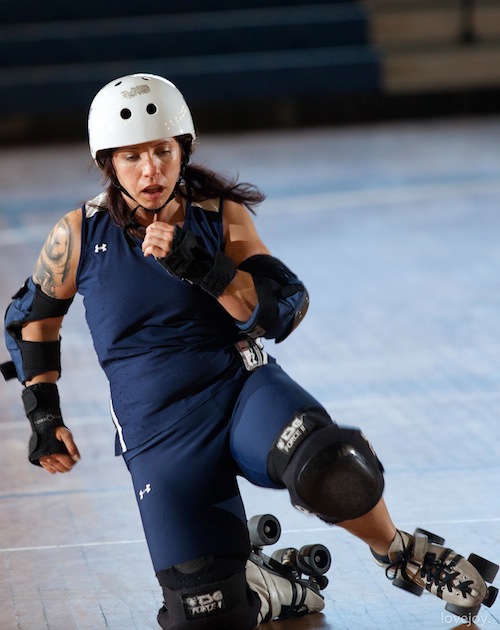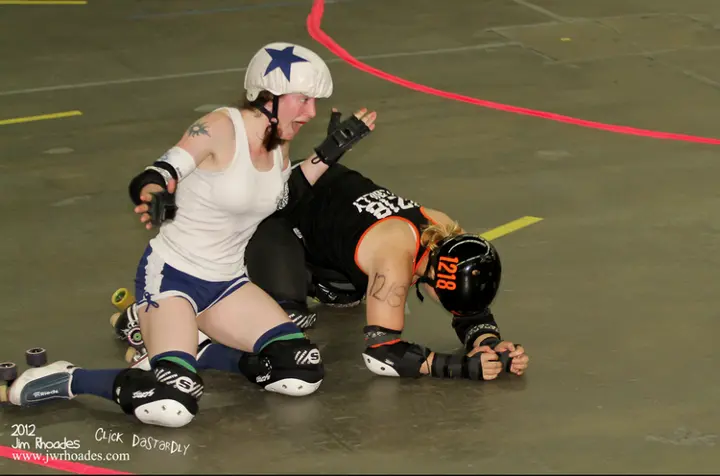
I'm just gonna say it: I hate falling drills. They're dumb and I hate them.
I started roller derby training in 2006, when training was like something from the dark ages. None of us knew what we were doing or how to do it. There were very few resources to help, so we spent endless practices working on obsolete skills like shoulder-to-shoulder blocking (I'll write a whole other blog on that one), dragging toe-stops, and baseball slides.
I like to think we've grown since then.
So why are we still doing falling drills beyond fresh meat training? Let's examine this.
1. Why do we learn how to fall? So we don't take down anyone with us or trip anyone once we've hit the floor. So we learn how to get up quickly. Okay, great, but shouldn't we be learning how NOT to fall? Wouldn't it be far more beneficial for skaters to spend time learning their center of gravity and how to manipulate it, how to extend their ability to almost fall and then pull back to a balanced point? When skaters begin learning how to block, they should also learn how to avoid blocks. No brainer, right?
2. Why do trainers incorporate falling drills into practices? For endurance, right? Psht. There are plenty of other endurance drills you can do to and really, if you are writing/leading a practice the whole thing should be an endurance test. Okay, well, don't skaters need to learn how to get up quickly when they do fall? Yep, and burpees and plyometric exercises will do that, too. I just don't see the point in slamming into the floor over and over when we should be learning how to stay up on our skates. Maybe you're thinking well, you shouldn't be slamming into the floor. If you're doing the fall correctly you're knees shouldn't take the weight of your body when you hit the floor. That's true, but when, in a real life jam, are you going down and you're able to brush your knees along the floor and swoop back up to a standing position? I don't fall much when I play derby, but I when I do it's because someone took me off guard with a mega-ridiculous-sick-ass-block (thanks Queen Loseyateefah - seriously, that was an amazing block and I tell people about how awesome you are all the time) or someone accidentally tripped me and there's no way to delicately fall in those situations.

3. Do other sports teach skaters how to fall? (I sometimes wonder if basketball players practice falling considering the way they flail around and can't get up unless some one helps them.) I searched online for the answer to this question and found nothing. Well, I found articles and drill suggestions for improving balance. Ha!
4. Regardless, I think falling drills are counterproductive. I know of several skaters who, when blocked or start to lose their balance, default to falling instead of trying to stay up. I think this happens because the muscle memory says it's time to fall, rather than find your balance! spin out of it! use the momentum! If those skaters had more balance training and less falling drills, I think they would spend less time kissing the floor and more time as an effective teammate.
I hate hate hate to sit out of any drill during practice, but I don't participate in falling drills for all the reasons above. Plus my knees are mush, and they hurt all the time already. I also hate teaching falls when I'm coaching. I want to teach balance!
I think falls were originally listed as a requirement for safety reasons and that makes total sense. At this stage in the evolution of training, though, I think it's far safer to eliminate falling drills and focus on balance training and avoiding blocks. Can we please do that? Okay? Okay.
Here is a simple balance exercise to getcha started.
Finding Your Center of Gravity
Knowing your center of gravity is crucial for every player. It is from this place a skater will begin to execute contact and it is this place a skater will attempt to find when she is blocked.
*Skaters spread around the track and coaches demo each skill, allowing skaters 2 mins to practice each:
- Stationary and in derby form, lean forward until you feel like you will fall, then pull yourself back to derby form. Vary your stance (feet together, feet shoulder width, feet wide as possible) to find the position that allows you to lean forward the furthest without falling.
- Do the same, but lean to each side.
- Do the same, but lean backward.
- Close your eyes and lean forward, sideways, and backward. Remember to vary your stance to find the position that allows you to lean furthest without falling.
- Stand on one foot and lean forward, sideways, and backward.
- Skating at slow pace: One-foot glides on straight-aways.
- Skating at slow pace: One-foot glides on corners at track boundary
- Skating at slow pace: Wacky Inflatable Guy. Throw your body all around to push your center of gravity to the edge. Bring it back to your derby stance when you feel like you are about to fall.

Falling Drills: Eff that.